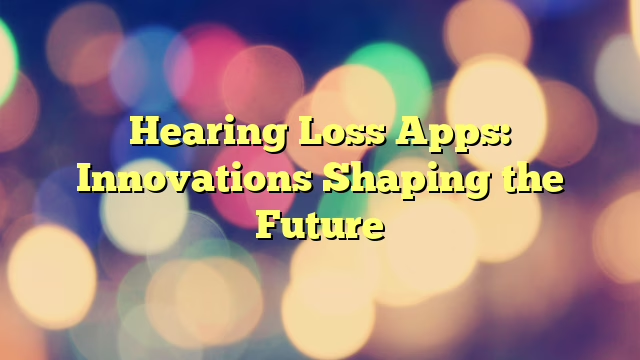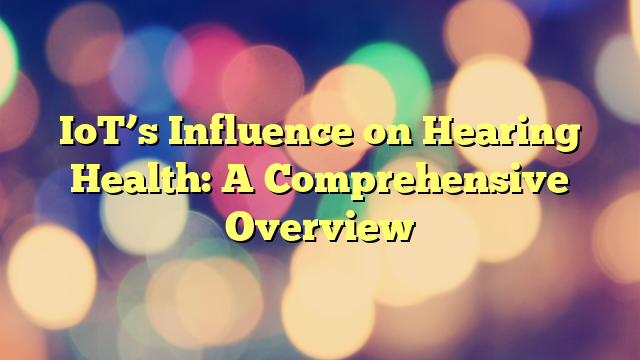Apps in Hearing Aid Control: Boosting Accessibility Features

Last Updated on 24/10/2025 by Admin
Unlocking the Potential of Apps in Hearing Aid Management
What Are the Key Functions of Hearing Aid Control Apps?
Hearing aid control apps represent a significant breakthrough in auditory technology, offering users the ability to control their hearing aids directly from smartphones or tablets. These innovative software solutions feature intuitive interfaces that empower users to customize their hearing experience according to their individual preferences. The convenience afforded by these apps has fundamentally changed how individuals interact with their hearing devices, drastically enhancing user satisfaction. Key functionalities typically found in these applications include:
- Volume Control: Easily modify the hearing aid volume for optimal sound.
- Program Selection: Seamlessly switch between various hearing programs tailored to specific environments.
- Environmental Adjustments: Tailor sound settings for unique situations, such as bustling restaurants or serene rooms.
- Remote Adjustments: Enable audiologists to fine-tune settings from a distance.
- Battery Monitoring: Track battery levels and receive timely notifications for replacements.
- Sound Personalization: Create customized sound profiles that suit personal preferences.
- Feedback Management: Mitigate disruptive feedback sounds using app settings.
- Streaming Support: Connect directly to smartphones for seamless audio streaming.
The ease of access and functionality provided by these applications make them indispensable components of contemporary hearing aid technology, significantly enhancing user engagement and satisfaction.
How Has Hearing Aid Technology Evolved Over Time?
The progression of hearing aid technology has been characterized by extraordinary advancements, transitioning from simple devices to highly sophisticated digital solutions. Initially, hearing aids were purely analog, employing basic amplification techniques. Over the decades, significant transformations occurred, with digital technology dramatically improving performance and usability. Today, the incorporation of apps offers an unparalleled level of user control. Important milestones in this ongoing technological evolution include:
- Early 20th Century: Launch of the first electronic hearing aids.
- 1960s: Shift from vacuum tubes to transistors, resulting in more compact devices.
- 1990s: Introduction of digital signal processing for enhanced sound quality.
- 2000s: Development of programmable hearing aids, enabling audiologists to customize settings.
- 2010s: Rollout of smartphone connectivity and app-based control.
- 2020s: Enhanced integration of artificial intelligence for personalized hearing experiences.
This historical trajectory reflects a relentless pursuit of improved auditory experiences, shaping the way users connect with their hearing devices.
Why Are Accessibility and User Experience Crucial in Hearing Aid Apps?
Applications designed for hearing aid control emphasize accessibility and user experience, empowering individuals to take charge of their hearing health. By simplifying the adjustment process, these apps promote seamless interactions between users and their devices. For example, intuitive designs enable users to easily navigate features, significantly reducing the learning curve commonly associated with new technology.
Additionally, many apps prioritize inclusivity by integrating features that accommodate diverse user needs. The visual interface often includes large buttons and clear icons, enhancing navigation for all age groups. Moreover, voice commands and haptic feedback improve usability, allowing users to engage with the app in challenging environments. These thoughtfully designed elements greatly enhance user satisfaction, making hearing aids more approachable and less intimidating.
What Are the Key Advantages of Utilizing Hearing Aid Apps?
Hearing aid apps offer a myriad of advantages that substantially enhance the overall auditory experience for users. A primary benefit is the capacity for remote adjustments, enabling audiologists to optimize settings without requiring in-person visits. This not only conserves time but also ensures users retain the most appropriate settings for their environments.
Another essential advantage is real-time data tracking. Users can monitor their hearing aid usage and performance, gaining valuable insights that facilitate discussions with audiology professionals. Furthermore, personalized sound settings allow individuals to tailor their auditory experience, making it easier to adapt to various scenarios, whether at a lively event or in a tranquil setting. Collectively, these advantages contribute to a more engaging and customized hearing experience.
How Do Apps Enhance Hearing Aid Functionality?
What Key Features Are Available in Hearing Aid Apps?
Hearing aid control apps are equipped with a wide array of features designed to enhance the functionality of hearing aids, making them more responsive to users’ needs. Some of the most notable features include:
- Volume Control: Users can swiftly adjust their hearing aids’ volume via the app.
- Program Selection: Apps facilitate switching between various preset programs tailored for specific environments.
- Environmental Adjustments: Users can modify settings according to ambient noise levels and situational demands.
- Sound Quality Enhancements: Options to fine-tune bass and treble settings for a personalized auditory experience.
- Direct Streaming: Connect smartphones or other devices for fluid audio streaming.
- Geo-tagging: Save specific settings based on location for automatic adjustments in familiar settings.
- Noise Reduction Features: Advanced options to minimize distracting background noise.
- Battery Life Management: Monitor battery usage and receive notifications for charging or replacement needs.
Every one of these features contributes to a comprehensive hearing experience, allowing users to engage with their environments more effectively and enjoyably.
How Do Hearing Aid Apps Integrate with Other Technologies?
Hearing aid apps frequently integrate smoothly with other technologies, providing users with a cohesive experience across various devices. For instance, users can connect their smartphones with hearing aids for direct audio streaming, enabling them to enjoy music, phone calls, and other audio content without intermediaries. This integration enhances user convenience, making interactions with diverse sound sources more straightforward.
Additionally, smart home devices may also connect with hearing aids, allowing users to control their environment directly through the hearing aid apps. Imagine adjusting the volume of a TV show or the sound levels of a smart speaker, all executed through the same app managing the hearing aids. This level of connectivity simplifies daily routines and enriches the overall user experience, as all aspects of sound become interlinked.
The benefits of these integrations extend to improved communication and social interaction. Users can engage with their surroundings without missing crucial audio cues, leading to more fulfilling experiences in social contexts or while participating in various activities.
How Do Customization and Personalization Affect Hearing Aid Use?
The ability to customize and personalize settings is one of the most compelling features of hearing aid control apps. Users can establish personalized sound profiles tailored to their unique hearing preferences, addressing the challenges they may encounter in different environments. This flexibility is particularly advantageous for individuals with varying degrees of hearing loss or those who experience fluctuating auditory needs throughout the day.
Through the app, users can modify equalization settings, allowing them to amplify specific frequencies or sounds that may be harder to detect. For instance, an individual might choose to boost higher frequencies to better perceive speech in crowded settings. The capacity for real-time adjustments enables users to respond dynamically to their environment, ensuring their hearing aids deliver optimal sound quality in every situation.
Moreover, the option to save multiple profiles allows users to switch between settings effortlessly, ensuring they are always prepared for any auditory challenge. This level of personalization not only enhances the effectiveness of hearing aids but also empowers users to engage more fully with their environment.
Expert Perspectives on the Impact of Apps in Hearing Aid Management
What Insights Do Experts Offer Regarding Hearing Aid Apps?
Experts in audiology and technology acknowledge the transformative influence that hearing aid control apps have on enhancing user experience and accessibility. Many assert that these apps serve as essential tools for fostering independence among users, enabling them to manage their hearing devices without constant reliance on audiologists. The convenience of remote adjustments marks a significant shift in how hearing health is approached.
Nevertheless, experts also highlight certain limitations. While these apps improve accessibility, they stress the need for user education to maximize their potential. Many users, particularly older adults, may struggle with technology, necessitating targeted training and support to fully benefit from these innovations. Looking ahead, experts anticipate that the integration of artificial intelligence (AI) and machine learning into hearing aid apps could further revolutionize personalization and effectiveness in hearing aids.
The consensus among professionals is clear: while the technology behind hearing aid control apps evolves swiftly, ongoing education and support are vital for users to harness their full potential.
What Real-World Examples Illustrate the Benefits of Hearing Aid Apps?
Real-world case studies provide compelling evidence of the profound impact hearing aid control apps have on users’ lives. For instance, a middle-aged teacher with moderate hearing loss leveraged an app to customize her hearing aid settings based on classroom acoustics. By adjusting her sound profile to amplify speech frequencies, she could interact more effectively with her students, leading to improved communication and enhanced classroom dynamics.
In a separate scenario, a retiree frequently faced frustration during social gatherings due to background noise disrupting conversations. By utilizing his hearing aid app, he successfully created a tailored setting that minimized environmental noise, significantly improving his listening experience. These examples highlight the practical applications of hearing aid control apps, enabling users to navigate diverse situations with greater ease and confidence.
Such case studies not only showcase individual successes but also emphasize the broader implications for community engagement and enhanced quality of life for hearing aid users.
What Future Trends Are Emerging in Hearing Aid App Development?
The future of hearing aid control apps is set for significant advancements, particularly in areas such as artificial intelligence, user interface design, and integration capabilities. As technology progresses, the incorporation of AI is expected to enable hearing aids to learn from users’ preferences and automatically adjust settings based on contextual cues. This level of automation could transform how users interact with their hearing devices, offering an unprecedented degree of convenience and personalization.
Furthermore, the demand for more intuitive interfaces is on the rise. Developers are concentrating on creating user-friendly designs that cater to a broader audience, including those who may not be particularly tech-savvy. Enhanced voice recognition features and simplified navigation are likely to become standard, making these apps accessible to all demographics.
Moreover, as connectivity with other smart devices increases, hearing aid apps will likely evolve to deliver even more integrated solutions, aiding users in effectively managing their environments. These trends herald exciting developments in hearing aid technology, promising to enhance the auditory experiences of users worldwide.
What Are the Notable Advantages of Using Apps for Hearing Aid Control?
Why Is Convenience and Ease of Use Important?
Hearing aid control apps exemplify convenience, allowing users to adjust settings effortlessly from their smartphones. Gone are the days when individuals had to struggle with tiny buttons or depend on audiologists for minor adjustments; the app offers a straightforward solution for real-time modifications. This ease of use significantly enhances daily management of hearing aids, especially for those leading active lifestyles.
For example, users can swiftly adapt their hearing aids to different environments by switching programs or modifying volumes with simple taps or swipes. This functionality not only saves time but also empowers users to take control of their auditory health independently. The intuitive nature of these apps often results in higher user satisfaction, as individuals feel more connected to their devices and, consequently, their hearing experience.
Additionally, the convenience extends to tracking usage data and receiving reminders for maintenance or battery replacements. This proactive approach to hearing aid management minimizes the risk of unexpected issues, ensuring that users maintain optimal hearing at all times.
How Do Hearing Aid Control Apps Contribute to Cost-Effectiveness and Accessibility?
The financial implications of utilizing hearing aid control apps are substantial. By reducing the necessity for frequent visits to audiologists for minor adjustments, these apps facilitate a more cost-effective management strategy for hearing aid users. Remote adjustments enable audiologists to provide support without requiring in-person appointments, significantly lowering healthcare costs for individuals.
Accessibility is another vital benefit. Hearing aid apps bridge gaps for users who may face difficulties accessing in-office services due to mobility issues or geographical constraints. With these apps, users can receive support and make adjustments from the comfort of their homes, ensuring equal opportunities for all individuals, regardless of their circumstances.
Moreover, many hearing aid manufacturers are recognizing the importance of affordability in the marketplace. As technology continues to advance, there is a growing trend of offering app functionalities at lower price points, making hearing aids accessible to a wider audience. This shift plays a crucial role in promoting inclusivity in hearing health.
In What Ways Do Apps Enhance Quality of Life for Users?
Hearing aid control apps can significantly elevate users’ quality of life by offering greater control over their auditory experiences. The ability to customize sound settings results in more enjoyable interactions in social settings, reducing the anxiety often associated with hearing loss. For example, users can easily modify their devices according to the setting—whether in a noisy restaurant or a quiet library—ensuring they do not miss important conversations.
Furthermore, the increased independence provided by these apps fosters a stronger sense of agency. Users can manage their devices without the constant need for assistance, which contributes to improved mental well-being and confidence. This empowerment encourages more social engagement, as individuals feel more comfortable participating in group activities and public events.
Additionally, tracking features enable users to monitor their hearing patterns and proactively address any issues. By understanding how their hearing aids perform in various environments, users can make informed decisions regarding their auditory health, further enhancing their overall quality of life.
What Challenges and Limitations Are Associated with Hearing Aid Control Apps?
What Technical Issues and Compatibility Challenges Can Users Face?
While hearing aid control apps provide numerous advantages, users may encounter technical challenges that can hinder their experiences. Compatibility issues between different devices and hearing aids can arise, leading to frustration. Users might discover that their hearing aids do not connect to the app or that certain features are inaccessible due to hardware limitations.
Common obstacles include Bluetooth connectivity problems, software bugs, and app updates that may temporarily disrupt functionality. Addressing these issues often requires patience and troubleshooting, such as restarting devices or reinstalling the app. Manufacturers must prioritize ongoing support and updates to ensure seamless user experiences, as technical difficulties can diminish the overall benefits of the technology.
Moreover, not all users possess the technical knowledge required to navigate these challenges. Thus, user education and accessible support resources are essential. Companies should provide comprehensive FAQs and customer service options to assist users in overcoming obstacles, ensuring they can fully utilize their hearing aid apps.
What Privacy Concerns Should Users Be Aware Of with Hearing Aid Apps?
Privacy concerns regarding data collection and storage are significant when considering hearing aid control apps. Users may feel apprehensive about the information these apps gather, such as location data and personal hearing preferences. The potential for data breaches or misuse raises legitimate questions about privacy and security.
To mitigate these concerns, manufacturers must prioritize transparency concerning data usage and storage policies. Users should be informed about what data is collected, how it is utilized, and the measures taken to safeguard their information. Furthermore, allowing users to customize privacy settings can empower them to control their data.
Educating users about privacy issues is equally critical. Many may not fully comprehend the implications of data sharing, making it essential for manufacturers to provide clear guidelines. By fostering trust and safeguarding user data, companies can reassure users, encouraging them to fully leverage the capabilities of their hearing aid control apps.
How Can User Adoption and Education Improve the Use of Hearing Aid Apps?
The adoption of hearing aid control apps can be challenging due to a lack of awareness and education among potential users. Many individuals remain unaware of the existence or capabilities of these apps, leading to underutilization of their hearing devices.
To boost adoption rates, manufacturers and audiology professionals must emphasize education and outreach initiatives. Workshops, online tutorials, and user-friendly guides can help demystify the technology and empower users to explore its features. Additionally, collaborations with audiologists can facilitate recommendations, ensuring that users comprehend the advantages of utilizing apps alongside their hearing aids.
Creating a supportive community around hearing aid app usage can further enhance user engagement. Online forums and social media groups can serve as platforms for users to share experiences, ask questions, and offer support to one another. This collaborative approach not only fosters a sense of belonging but also encourages individuals to take an active role in managing their hearing health.
Effective Strategies for Leveraging Apps in Hearing Aid Control
What Best Practices Should Users Follow When Selecting an App?
Choosing the right hearing aid control app is crucial for effective management of hearing aids. Users should consider several factors when selecting an app to ensure it aligns with their needs and preferences. First and foremost, compatibility with their specific hearing aid model is essential. Users should verify that the app supports their device to prevent functionality issues.
Next, the user interface should be intuitive and easy to navigate. Individuals should seek out apps that provide clear instructions and well-organized features. Additionally, exploring user reviews and ratings can yield insights into the app’s performance and reliability.
Another vital consideration is the availability of customer support. A robust support system can significantly enhance the user experience, offering assistance with technical issues or inquiries. By adhering to these best practices, users can select an app that maximizes their hearing aid functionality and overall satisfaction.
How Can Users Optimize the Benefits of Hearing Aid Apps?
To fully optimize the benefits of hearing aid control apps, users should embrace specific strategies that enrich their experience. Regularly updating the app guarantees access to the latest features and enhancements, creating a smoother user experience. Additionally, users should take the time to explore all available functionalities, such as customizing sound profiles or utilizing remote adjustment features.
Engaging with the app’s analytics can provide valuable insights into hearing habits. By tracking usage patterns, users can identify which settings work best for them in various environments, facilitating informed discussions with audiologists.
Furthermore, incorporating app usage into daily routines can reinforce positive habits. For instance, users can make it a habit to check their app for battery levels or adjust settings before heading out, ensuring optimal performance. By actively participating in their hearing management, users can enhance their overall auditory experience.
Why Is Collaboration with Healthcare Providers Essential?
Collaboration with healthcare providers is vital for the effective use of hearing aid control apps. Users should establish open lines of communication with audiologists and other hearing health professionals, sharing insights and experiences related to app usage. This collaboration can yield tailored recommendations, optimizing hearing aid settings based on individual needs.
Audiologists can also offer valuable training and support, assisting users in navigating app functionalities and troubleshooting any issues. Regular check-ins with healthcare providers can ensure that users remain engaged and informed about their auditory health.
Additionally, professionals can help set goals related to hearing aid usage, encouraging users to track their progress through the app. This collaborative approach not only boosts user confidence but also fosters a more proactive attitude toward hearing management.
What Are the Best Ways to Integrate Apps into Daily Life?
Integrating hearing aid control apps into daily life encourages consistent and effective hearing management. Users can develop routines that incorporate app usage, making adjustments a natural part of their day. For example, setting reminders to check battery levels or modifying settings before entering specific environments can reinforce positive habits.
Moreover, utilizing the app’s features during social interactions can enhance engagement. Users can adjust their settings based on noise levels or environments, ensuring they do not miss essential conversations. Encouraging family members or friends to participate can also create a supportive atmosphere, nurturing a sense of community around the user’s hearing experience.
By actively incorporating apps into their daily routines, users can maximize potential benefits, leading to improved auditory experiences and greater overall satisfaction with their hearing aids.
What Innovations Are Shaping the Future of Hearing Aid Control Through Apps?
What New Developments Are Being Made in App Design?
Innovations in app design continuously enhance the functionality and user experience of hearing aid control apps. Developers are increasingly focused on creating intuitive interfaces that cater to a diverse audience. This includes integrating larger buttons, simplified navigation, and visual cues that facilitate interaction for users of all ages.
Another emerging trend is the incorporation of gamification elements to boost user engagement. By transforming the process of managing hearing aids into a more interactive experience, users are more likely to explore the app’s features and make necessary adjustments. Features like progress tracking or rewards for consistent usage can foster a sense of accomplishment and motivation.
Additionally, voice-activated controls are becoming more prevalent, enabling users to make adjustments hands-free. This level of innovation not only enhances accessibility but also aligns with the growing trend of voice-activated technology across various devices. As app design continues to evolve, the potential for creating engaging, user-friendly experiences is limitless.
What Role Will Artificial Intelligence Play in the Development of Hearing Aid Apps?
Artificial intelligence is set to play a transformative role in the future of hearing aid control apps. By utilizing machine learning algorithms, these apps can analyze users’ hearing patterns and preferences to provide personalized recommendations automatically. For example, the app may learn which settings a user prefers in specific environments, adjusting automatically as they enter those spaces.
Furthermore, AI can enhance sound processing capabilities, allowing hearing aids to differentiate between various sounds and prioritize crucial audio cues, such as speech. This level of sophistication can significantly improve the hearing experience, particularly in challenging environments like crowded gatherings or busy streets.
Moreover, AI-driven analytics can offer users insights into their hearing habits, empowering them to make informed decisions regarding their auditory health. By delivering data-driven recommendations, AI not only enhances user satisfaction but also fosters a deeper understanding of individual hearing needs.
How Are Market Trends and Consumer Demand Influencing Hearing Aid Apps?
Market trends and consumer demand are propelling the rapid development of hearing aid control apps. As awareness surrounding hearing loss and audiology continues to increase, more individuals are seeking innovative solutions to manage their hearing health. This rising demand is prompting manufacturers to invest in app development, ensuring that features align with user expectations.
Additionally, the growth of telehealth services has created an increased need for remote solutions, encouraging the adoption of hearing aid control apps. Consumers are looking for convenient, cost-effective ways to manage their hearing aids without the burden of frequent in-person visits.
As a result, the market is undergoing a shift toward integrated solutions that combine hearing aids, apps, and telehealth services into a cohesive offering. This trend reflects a broader movement toward personalized healthcare, where users seek solutions tailored to their specific needs. Manufacturers that prioritize user experience and respond to consumer demand are likely to lead the way in this evolving landscape.
Frequently Asked Questions About Hearing Aid Control Apps
What Are Hearing Aid Control Apps?
Hearing aid control apps are mobile applications that allow users to manage and customize their hearing aids through smartphones or tablets, offering features such as volume control and program selection.
How Do Hearing Aid Apps Enhance User Experience?
These apps improve the user experience by providing tools for easy adjustments, personalized settings, and real-time data tracking, enabling users to manage their hearing aids conveniently.
Can I Customize My Hearing Aid Settings Through an App?
Yes, most hearing aid control apps allow users to customize settings, including sound profiles and adjustments for different environments tailored to individual preferences.
Are There Privacy Concerns with Hearing Aid Apps?
Yes, privacy concerns may arise regarding data collection and storage. Users should review the app’s privacy policy and adjust settings to protect their information.
What Are the Benefits of Using Hearing Aid Apps?
Benefits include convenience in adjustments, remote support from audiologists, personalized hearing experiences, and the ability to track usage data for informed decisions.
How Can I Choose the Right Hearing Aid App?
Consider compatibility with your hearing aid model, user-friendly design, available features, and customer support when selecting a hearing aid control app.
What Role Does AI Play in Hearing Aid Apps?
AI enhances hearing aid apps by providing personalized recommendations, improving sound processing capabilities, and offering insights into user hearing patterns.
Can Hearing Aid Apps Be Integrated with Other Devices?
Yes, many hearing aid apps can integrate with smartphones, smart home devices, and other technologies, creating a seamless user experience.
What Challenges Might I Face When Using Hearing Aid Apps?
Users may encounter technical issues, compatibility challenges, and privacy concerns. Educating oneself about the app and seeking support can help mitigate these challenges.
How Can I Maximize the Benefits of My Hearing Aid App?
To maximize benefits, regularly update the app, explore all features, engage with its analytics, and incorporate app usage into daily routines for optimal hearing management.
Explore our journey on X!
The post Apps in Hearing Aid Control: Boosting Accessibility Features appeared first on The Microsuction Ear Wax Removal Network.




















